back to introduction -- Rome on Foot: Walk One
Free Sample of Rome on Foot: WALK ONE -- download pdf of this walking tour
This page is designed to give you an idea how the ebook functions, with interactive videos, many photos, detailed maps and text describing the sights. The ebook works well on Kindle and Nook, but the videos are specifically designed to play in Apple devices like iPad, iPhone and iPodtouch. This page simulates that interactive experience. When you play a video you can choose 720p High Definition and full-screen mode by selecting in the menus on the bottom of the video frame.
Campo dei Fiori; small lanes; Chiesa Nuova; Piazza Navona.
CAMPO DEI FIORI
Begin your first morning in the center of Rome at Campo dei Fiori, Rome's best outdoor fruit and vegetable market. Then spend the rest of the day on a walking tour through some of the most fascinating and historic neighborhoods within the curve of the Tiber River.

Campo dei Fiori is teeming with friendly people, tasty fruits, vibrant colors, animated conversations, varieties of vegetables, sweet smells, energetic vendors, local shoppers, and atmosphere galore. This setting is perfect, surrounded by very old buildings with cobbled pedestrian lanes leading off in all directions into a great neighborhood we shall explore next. This friendly and lively piazza is one of the major focal points of the city, just three blocks south of Piazza Navona (coming up later in this walk) and an easy walk if your hotel is in the historic center. If you're staying further away, take a taxi.
Arriving any time in the morning is good, but earlier is better. Campo dei Fiori makes a great start for our walk: it is the only main attraction opening by 6am and it is simply a wonderful morning scene. This magical Campo has multiple personalities, changing character throughout the day: Rome's main veggie market in the morning, a ring of busy restaurants at lunch, peaceful in the afternoon, and a party scene at night.
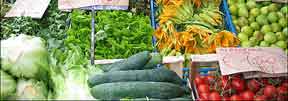
Campo dei Fiori's produce stands are very popular with the nearby residents and chefs seeking fresh items on their daily shopping rounds. This is a perfect place to spot the locals and strike up a conversation if you wish. Most of the people are quite friendly and speak some English but what you hear most is the beautiful sound of Italian when vendors shout out their offerings. Too often we neglect to listen while traveling: a pity, because sound is the fourth dimension and often produces a symphony of delights such as here at the market.
Nearly all the vendors have worked here for years and know each other like family, making for a cooperative, communal attitude. Ladies traditionally do most of the trimming to get the produce ready for display, so watching their deft moves might give you a few ideas for speeding up your own food-prep techniques.
You are probably not going to be cooking, but this is a good spot to pick up some refreshments (fruits, olives) drink some more coffee, take a lot of pictures and just soak in the atmosphere. The fruits are ready-to-eat and can be washed in the convenient drinking fountains at either end of the campo. You will even find a few clothing stalls and souvenirs scattered among the local wares, including some tourist t-shirts, but the choices are limited.


One favorite stand specializes in dried herbs for pasta sauce and special green olives that are unique to Rome – these are fresh olives just lightly brined and with a clean and refreshing taste, like no other olive you have eaten. The clever merchant will offer some free samples to get you interested, if you ask, so be sure to have a taste. You can buy a few small bags of these green olives and keep them a few days for tasty snacks down the road. The dry herbs for pasta sauce will pack nicely in your suitcase, staying fresh for many weeks, and make good gifts for friends. When you get home, make some authentic Italian spaghetti sauce to remind you of your visit to this lively square.
A special item that comes into season during the fall, usually October and September, is the truffle, the wonderful truffle of Italy. It's quite expensive, perhaps $200 for a little piece, but more affordable as an ingredient of your meal in a good restaurant. The classic presentation is served freshly sliced onto a simple pasta dish with a plain oil or butter sauce, which allows the pungent, earthy truffle aroma to explode in your mouth. The finest truffles are the white variety from Piedmont, tastier than the more famous black French version.

.jpg)
Porcini mushroom is another specialty at the market, one of Italy's unique wild foods offered primarily in the fall. These big fungi don't travel well, so you generally don't find them served fresh outside Italy. Most good restaurants in Rome will offer them in season, and the porcini mushroom is absolutely worth tasting, either as an ingredient in the pasta sauce or as a dish unto itself grilled to firm perfection. They have become so famous that some have been marginally cultivated in other parts of the world, and dried packets are widely available – but dried is nothing like the real thing.
In olden days this peaceful piazza was sometimes used as a field of execution as witnessed by one monument to the gruesome past: The bronze statue high on a pedestal in the middle is the hooded, brooding Giordano Bruno, burned at the stake on this very spot for heresy in 1600. He agreed with Galileo in his great dispute with the Church that the Earth was not the center of the universe. Bruno's thoughts went beyond Galileo -- he speculated that not only is Earth a small object in a very large universe, but that there might also be other universes, something modern astronomers are considering today.
The morning market is what makes the campo unique, so if you are an early bird trying to squeeze the max out of your Rome hours or someone waking up early from jet lag at the start of a trip, do consider coming here first thing in the morning, even as early as 6:00am when the vendors are just starting to set up their stands. In this pre-dawn bonus hour you will see all manner of oddball, wheeled devices being pushed, pedaled and driven into the still-dark piazza as merchants bring stands from their overnight storage in nearby warehouses. Crates of produce stacked high are delivered by tiny three-wheel trucks (more like overgrown mopeds). Umbrellas are raised, peaches arranged, white-smocked fish-vendors march in, conversations ring loud in the air with the fountains burbling and the antique lamp posts still shining in the dark blue, pre-dawn sky above. It is quite a free show.

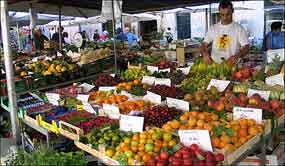
Another bonus for the early-riser is coffee! There are several cafes within a block of the Campo dei Fiori that are open by 6am and pumping out that dark fuel and cornets – the typical Roman pastry to get you going. It is likely your hotel doesn't serve breakfast until seven, typical of most of the hotels in the city, so if you're looking for some place that's got interesting activities going on, with coffee service, come on over. It's fun to just hang out and watch everybody getting set up for their morning's work. By seven o'clock the vendors are fully open for business and the second act of this street theater has begun.
Of course if you'd rather sleep in, arriving any time in the morning is fine, for you can see the wonderful sights going full-tilt until noon: dozens of stands loaded with fresh produce, fruits, vegetables, salads, fish, flowers (Campo dei Fiori translates as "field of flowers") and a newsstand. The little piazza is a great place for taking colorful pictures of bright red, yellow, purple, pink and green fruits 'n veggies, as well as candid people photos of the workers and shoppers, most of whom are so busy they won't notice you pointing your camera at them. (Photo tip: it's usually better to include a person somewhere in your shot, even if in the background.)
.jpg)
.jpg)
Don't come too late because by mid-day most food stands have shut down -- the merchants have packed up their goods and pushed them back into the nearby warehouses for overnight storage. The center is clear, ready for the next act. Around noon it transforms into a popular luncheon piazza, encircled by a dozen outdoor restaurants which are fascinating to observe, and tasty, if rather touristic: fine for simple pizza, salad, pasta or drinks, and ideal for its people-watching atmosphere from an al fresco table. If you are hungry for excellent food, the adjacent lanes are sprinkled with better choices, such as Ditirambo, Costanza and Teatro di Pompeo.
Later in the afternoon, things get quiet in the Campo as it settles into the typical local rhythm of siesta, but then action picks up again before twilight as the city comes back to life. Of course in our suggested walking tour, you are just visiting in the morning and then moving on with the rest of the itinerary, but try and find time to come back here on your own later, even at night, such as we suggest at the end of Walk Four.
The Campo dei Fiore becomes a lively party scene in the evening when wine and beer flows like water and hundreds of people gather at the tables and stand in the plaza, chattering and laughing.
BIG PALACE and LITTLE LANES
Have a look at the huge Palazzo della Cancellaria at the north corner of the Campo dei Fiori, and if the big doors are open, walk inside the impressive courtyard that has a large two-level surrounding loggia built partly with stones and columns scavenged from the ancient Theater of Pompey and Colosseum. This palace is extra-territorial property of the Church (the Vatican State) and is not part of Italy. The Palazzo was the first Renaissance palace in Rome, built for the family of Pope Sixtus IV and finished in 1513, but it was seized a few years later by arch-rival Pope Leo X. Palazzo della Cancellaria is an immense building but only has three floors – they built very high ceilings for the rich in those days.
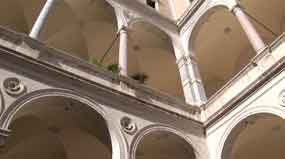
One block over on Corso Vittorio Emmanuelle you could visit the Barracco Museum, which consists of a prestigious collection of antique sculpture: Assyrian, Egyptian, Cypriot, Phoenician, Etruscan, Greek and Roman art.
Meander alongside the Cancellaria palace on the little alley to the left called Via Pellegrino, named for the pilgrims who used to trod this route on their way to the Vatican. Notice the doorway on your left-hand side, through the iron gate that is generally open, allowing you to walk into a typical residential courtyard.

As long as you are quiet and respectful, the neighbors won't even notice you are standing there. Have a look at this scene, which is so picturesque that it has appeared in postcards and books -- so take a few snaps and appreciate this tranquil residential beauty. Continuing along Via Pellegrino, cut through the first alley on your left to V.d. Cappellari, through the graffiti-scarred arch and turn left, returning to Campo dei Fiori.
This neighborhood was at the center of Renaissance Rome and has since gone through periods of decay and rebirth, lately becoming a trendy and expensive place to live. Amazingly, these and other charming, narrow lanes coming up next are nestled in the heart Rome, yet few tourists ever find them.
Cobblestones form the surface of nearly all roads in the center of Rome and they take a little getting used to. Don't wear spike heels! Cobbles provide a nice surface to walk on if you are wearing good shoes, which you should be doing anyway (preferably running shoes or at the very least, high-quality walking shoes). The rounded surface contour of the cobblestone is a bit uneven and yes, you could trip if you are careless, but when you get used to the rounded contours and go with the flow they can feel better than a smooth road. These bumpy surfaces give your ankles a flexible workout and can offer the bottom of your feet a light touch of massage with their rounded shapes.
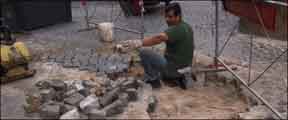
Each individual cobble is a surprisingly long rock which is simply planted in wet sand, like a big stone tooth -- there's no asphalt or cement bonding, making it easy to dig the stones up when repairs are needed, and then put them back in place. At some point in your walking, you are bound to come across one of these little construction areas with piles of cobbles next to a sandy hole in the ground, and probably no-one working. But if the workers are there, pause a moment and watch their skill as they pound the stones back in place with the ring of their steel hammers on hard rock.
SANT'ANDREA
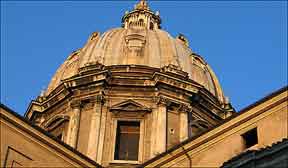
Walk two short blocks from Campo dei Fiori to one of the city's most beautiful and important churches, Sant Andrea della Valle. The interior is elaborately decorated in the Baroque style and boasts the second highest dome in Rome after St. Peter's. Step inside the huge church to admire its beautiful design, mostly created between 1590 and 1650; the façade came a bit later, and many decorative elements were added in the following centuries. This is the first of many important churches we will recommend for your time in Rome – not all 500, and not so many that "they all look alike," but just enough to dazzle you.
The wealth of Roman society was poured into creating decorations for these churches, especially during the Counter Reformation of the late 1600s: impressive interiors developed with spectacular décor, vast spaces, numerous statues, divine ambience, and benches where you can sit and rest. Visits to the churches are not religious pilgrimages but a search for artistic beauty that can be enjoyed by all. During the Renaissance and Baroque periods, 1500-1700, the Church was the great patron of the arts. Painters, sculptors and architects of the day did most of their major commissioned work in these churches and produced an amazing legacy for us to enjoy today, and it is all free. Churches were the museums, monuments, MTV, CNN and theater of that time, with so much diversity that no two churches are alike.
As soon as you enter a huge church like Sant Andrea della Valle, stop to experience the full size of the space. Let the visual spectacle sink in with a single glance – put the camera and notes aside for a moment and just soak up the scene. You don't get many chances in life for first impressions like this one, so don't belittle it by getting immediately lost in your viewfinder or distracted by little details, not seeing the forest for the trees. Catch your breath, then then take some pictures and continue exploring this vast space by walking around to discover the different angles that reveal numerous perspectives.
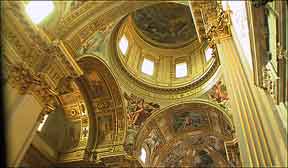

Many artists worked to create this golden assemblage, which fits together so well that it seems the product of a Master Planner, but Sant'Andrea was fashioned by such luminaries as Giacomo della Porta (who created the initial architecture), Lanfranco, Domenichino, Fonatana, Algardi, Rainaldi and dozens more. Its main highlights begin with the overall effect of vast space, golden decor and painted ceilings; the high dome; St Andrew (Sant Andrea), crucified upside down on the X-cross in a painting over the altar; and a bronze full-size copy of Michelangelo's Pieta (its original coming up in Walk Three in St. Peter's) in the second chapel on the right. Look for the mirror mounted on a floor stand at the crossing: it allows you to look at the dome without breaking your neck, because you look down at the mirror into a reflection of the ceiling.
The recently renovated interior is glistening with gold leaf that seems to cover half the ceiling and much of the walls, bouncing a yellow glow throughout the space. This decoration was part of the church campaign to hold on to the faithful and fight back against the Protestant revolution during the Counter Reformation. Scenic splendor was meant to attract the faithful so they would continue worshiping in the traditional Catholic way. Another element of the Counter Reformation found here is the huge nave intended to hold a large congregation.

.jpg)
Photo tip: While it may seem bright in here, especially with those golden surfaces and large windows, your camera is not as sensitive as the eye and will shoot with a slow shutter indoors, producing blurry shots which might seem clear on your tiny camera screen, but when you blow them up on your computer or in a cropped print they will fall apart into the fuzz-zone. Brace your camera by placing it against something solid, like a railing, pillar, wall or chair, establishing direct contact of the camera to something solid without putting your hand in the middle; hold your breath and squeeze slowly without a jerk.
Walk alongside the church on Via dei Chiavari, another charming cobbled lane with old apartments above and a few shops and restaurants at street-level. This historic neighborhood was the site of a major theater built 2,000 years ago by the famous general, Pompey, as part of his campaign to impress the public and gain power, in competition with Julius Caesar who was assassinated nearby, although no one is certain exactly where. Evidence of Pompey's Theater can be seen in the curvature of apartment buildings on the right bulge of the lane, built much later but following the old alignment. Some of the theater's brick walls can be seen around the corner inside Costanza Restaurant, another good place to eat, especially noted for their bean soup, pasta e fagioli, especially if seated in their historic room on the left.
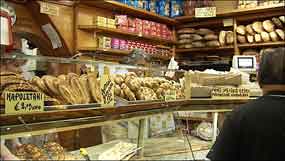
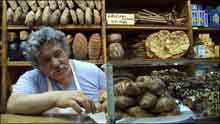
Further along Via dei Chiavari you might enjoy a visit to the famous Roscioli Bakery. Step inside to appreciate their fresh-baked breads, tasty variety of cookies, pastries and fresh pasta. Roscioli recently expanded to include a luncheon counter that serves sandwiches, pizza and other take-outs, so it's no longer just a bakery. Roscioli is a high-quality place, so expect to pay a premium -- worth it because the bread is fantastic, both white and hearty dark. As you will discover in most of the restaurants here, Roman white bread is something special: its rough, chewy texture makes it unique, and it is healthier and tastier than normal soft bread. You could grab a snack now,or wait a minute until you get to the little pizzeria around the corner.
VIA GIUBBONARI

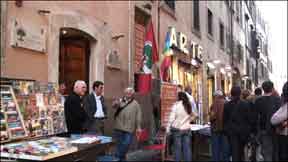
Exit the bakery, turn right, and continue a half block to Via Giubbonari, one of the most charming streets in Rom still lined with shops selling clothing as it has for centuries. Stores open about 10am here, as throughout town, so they might just be opening for you, depending on your timing this morning. If you are in the mood for browsing, by all means do so.
Refreshment is served by the slice at the casual pizzeria, Voglia di Pizza, with simple outdoor tables that offer ideal people-watching perspective as this little street comes to life. Another fragrant food experience awaits in the gourmet deli nearby on Via Giubbonari, a branch of the Roscioli Bakery expanded into a wine bar and small restaurant.
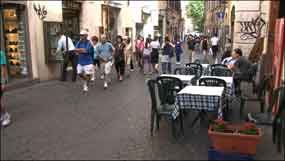

At the far end of Via Giubbonari, you could enter San Carlo ai Catinari, typical of the Baroque churches of Rome built during the mid-17th century, which was a time of tremendous development and artistic growth in this city. This is definitely optional because many more spectacular churches are coming up in the next few days, but the interior does have a beautiful view up at the high dome, a painting by Pietro da Cortona behind the altar, and a lovely chapel on the right side with an oculus surrounded by stucco angels dramatically concealing a hidden window.
Return now once again along Via Giubbonari – you won't mind backtracking on this charming shopping lane which really is one of the nicest in the city. Continue five blocks back to Campo dei Fiori, then turn left and walk one block to see the city's biggest palace.
PIAZZA FARNESE
Piazza Farnese is most notable for the impressive Palazzo Farnese, one of the largest and most famous Renaissance palaces. Various important architects helped create it, including Michelangelo, who designed the central windows above the door and the long cornice at the roofline. Construction began in 1517, the same year the nearby Palazzo della Cancellaria was finished. Ironically that is the same year Martin Luther began the Protestant revolution – a curious coincidence since this big palace was built for Alessandro Farnese, who became Pope Paul III and presided over the Council of Trent which condemned the Protestant Reformation and codified basic Catholic doctrines.

Famous ceiling murals were painted inside by Annibale Carracci using the elaborate Baroque style he invented: they depicted among other mythological scenes, "The Loves of the Gods." Unfortunately the public is not allowed inside because this is a private building housing the French Embassy. France enjoys cheap rent, paying only 1 euro per year, but so does the Italian Embassy in Paris. You must have official business to go inside, but there are nice photos on display in the piazza showing some of those paintings along with descriptions of the artwork.
A large courtyard and lush green garden is hidden from view behind the building. The attractive Piazza Farnese has two impressive fountains in granite basins taken from the Baths of Caracalla. There are restaurants on both sides and a snack bar on the corner for a simple drink or light meal.
VIA GIULIA
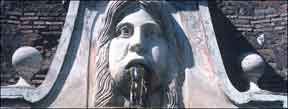
Walk behind the palace on the street to the left, Via d. Mascherone, to Via Giulia, where you'll encounter a face on the wall with water shooting out of its mouth, the Fontana del Mascherone (1626).
Via Giulia is a relatively wide, straight road that was a major thoroughfare during the Renaissance about 500 years ago, leading from downtown to the Vatican, lined with palaces which have been divided up into expensive apartments. Notice how many doorbells you find at each of the many large doorways.
-slide.jpg)
The arch across the street connects the Farnese Palace with their private church. The road is named after Pope Julius II, the great Pope who hired Michelangelo to paint the Sistine Chapel and also commissioned Raphael to paint his private rooms in the Vatican during the Renaissance.

Over the centuries this neighborhood went up and down in quality, but it has thoroughly bounced back now as a very expensive, restored district with exclusive apartments in the former palaces and a few art galleries, antique shops and offices at ground level. Centrally located housing like this has extra value because residents don't have to fight rush-hour traffic, and instead can walk to work. Continue a few blocks on Via Giulia, then turn right to Via di Monserrato, one of the many quaint, charming little streets in this neighborhood. Turn left and walk in the street, but listen up for cars. Considering how narrow the sidewalks are here, typical of Roman lanes, it is easier to walk in the street, but keep your ears open for the cars or scooters that will be coming up behind. You will hear them, so just stay near the side as you walk along to make it easier for the cars to get by. While this neighborhood seems like a pedestrian zone, there will be a few cars, scooters and tiny little trucks zipping past, so just be aware.
You will love walking through these cobblestone lanes, peeking into the little courtyards and admiring the façades. Many of these buildings are 400 years old and have been continuously occupied. This street and nearby lanes are so photogenic they are often used as locations for feature films, TV programs and model shoots. It's very rewarding in your travels to have some time when you can simply walk through these quiet, peaceful, residential streets. They're very historic but they don't have major headline monuments -- it's a meander that takes you off the beaten track and into the neighborhoods where actual Romans live and very few tourists ever venture.

After a few blocks walking along Via Monserrato, you will arrive at a tangle of six lanes coming together at a confusing yet picturesque little intersection – a good spot to pause for a moment and take in the local scene. Exit along the very narrow Via d. Cartari, keeping to one side so cars can get by, then cross the busy Corso Vittorio Emanuele II and enter another highly-decorated church, Chiesa Nuova.
CHIESA NUOVA
Chiesa Nuova will dazzle you with marvelous Baroque-style paintings on the ceiling and dome, along with carved angels and shimmering gold all set in a vast, spiritual space. The murals were created by the most famous ceiling painter of the day, Pietro da Cortona, who created one of his great masterpieces here. This is a sight not to be missed, and it's also good place to sit down and rest.
.jpg)
Notice the two sets of golden organ pipes on both sides, recently renovated and glistening like solid gold. Chiesa Nuova was built for a priest named Father Filippini Neri, who was a great leader of the church and founder of the order of the Oratorians, which still has branches throughout the world. The small chapel left of the altar contains a lovely painting of St. Neri. Saint Neri believed in a life of joy, simplicity and humility. To become a member of the order in his day, you had to wear donkey ears, a burlap sack and parade through town, showing your humility. A door to the left of the small chapel leads to the sacristy, where you could purchase postcards of the church and also inquire about the toilet if you are in need.
.jpg)
The large angels along the upper portion of the nave are crafted in the style of Bernini, although he played no direct role in decorating this church. You will be seeing many works by Bernini during your visit to Rome, who, along with Michelangelo, was the greatest of all Italian sculptors, and his indirect influence is certainly noticeable in this church. The angels are made from stucco, a marble dust mixed with plaster and molded, then polished to look like marble that was carved. You will find stucco sculpture in many churches; it's very durable and makes a very nice, smooth surface.
Chiesa Nuova means "new church" but of course by now it is no longer new. The official name is Santa Maria in Vallicelli, Our Lady in the Little Valley, but everyone calls it Chiesa Nuova. Construction began in 1575 and it was consecrated by the end of that century. This church had no interior decoration when first built, in keeping with the wishes of Father Neri. After his passing, the church brought in major painters and sculptors to create the extremely elaborate decorations that we see today.
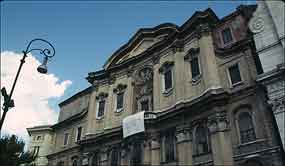

Immediately adjacent to Chiesa Nuova is the Oratorio, which, although it looks like another church from the outside, contains offices and facilities associated with Chiesa Nuova, including a small avant-garde theater and the oldest public library in Rome.
The Oratorio is notable because of the beautiful curving façade that was designed by Borromini in his typical style, combining the concave with the convex in his special undulating rhythm. There is quite a contrast in architectural styles between these two façades: the curving Borromini-esque on the left, and the plain white Chiesa Nuova on the right. While outside facing the pretty building, you will soon be walking along the alley on the left side, but first consider a food diversion.

If for some reason you are here during lunch time and are hungry, or want to make note of the location of a great restaurant to find later, return across the busy Via Vittorio Emanuele and walk over to the excellent restaurant, Da Luigi, on the first corner to your right. This classic spot is an authentic local eatery where you can have an excellent meal, choosing from their diverse menu of fresh pasta, pizza, fish, meats, salads and antipasto buffet. You will find few tourist in this typical Roman restaurant since it is away from the main sightseeing and hotel districts, yet close enough you can easily come back here for a fine meal.
You are welcome to have a look in the kitchen of this friendly eatery, where you can observe the true Italian system of cooking pasta: boil fresh (hand-made) noodles for a few minutes, then sauté in a pan over flames, swirling together with sauce that combines all the food ingredients in a heavenly combination. Italy has banned cigarette smoking inside restaurants, so for clean air choose an inside table; however the real action takes place outdoors on Da Luigi's extensive terrace in this small Piazza Sforza Cesarini.
Walk around the left side of Chiesa Nuova and Oratorio, along Via d. Filippini, and you'll see a beautiful clock tower at the back corner, the Orologia, designed by Borromini. Notice Borromini's typical convex and concave curves on the little façade of the clock tower. This neighborhood is just filled with interesting streets – you could come back and wander for hours, but for now, walk along the main street just behind the church.
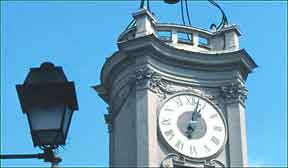
In one direction, to your left, it is called Via dei Banchi Nuovi, which translates as "street of the new bankers" because during the Renaissance this was the Wall Street of Rome, home of the bankers – the financial center of town. The same street, to your right, is called Via del Governo Vecchio and it is this direction we shall be heading. But first you might enjoy a quick stroll two blocks along Banchi Nuovi to see the antique and furniture restoration shops, pop into the café if you need a break, then return, heading east towards Piazza Navona, our next major destination.
Via del Governo Vecchio is a casual, local place where you see the people passing their time of day, chatting with neighbors, looking out their windows, walking the dog, shopping, and just hanging out.
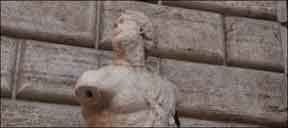
Governo Vecchio ends at Piazza Pasquino, where you find one of the "talking statues" that functioned like bulletin boards for Romans who would post messages and especially make satirical comments about issues of the day. The statue is originally from the Hellenisitic period of 300 BC but was placed here during the 1500s when it began its role as community forum. People are still using the talking statue today, so you will probably see paper notices attached to the broken torso. One of the many branches of Insalata Ricca, a popular place for salad and pasta, is on this little piazza.
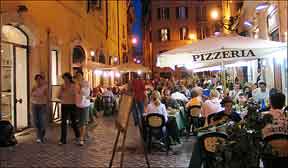
This neighborhood is more interesting late in the day when it becomes a magical gathering place for eating, shopping, strolling and soaking up the scene. We suggest you come back at the end of Walk Four. Now we are merely passing through on our way to Piazza Navona just four blocks away.
Although we're heading to the Piazza Navona around the corner, you could detour one block to the right and visit the Museum of Rome, with exhibits about the city history from the Middle Ages into the 20th century. Only those really interested in this period need venture in, for the exhibits are mostly furniture, decorative arts, clothing, graphics and paintings by minor artists.
PIAZZA NAVONA
Now you have arrived at a very special place: Piazza Navona is considered one of the most beautiful and lively outdoor spaces in the world. You will probably return here several times, for it is centrally-located and interesting at all hours. Originally built as a racetrack by the Roman emperor Domitian in the 1st century, it still retains the original oval shape giving it a unique appearance.
.jpg)
Lined with restaurants and palaces, the piazza is enclosed all around by faded pastel facades which produce a rich feeling of antiquity. Sant'Agnese in Agone church by Borromini faces Bernini's stunning Fountain of the Four Rivers in the center, two artists you will encounter several more times in Rome. Along with Piazza di Spagna, coming up in a few hours, this is one of the two most popular squares in the city – the most fun, with something for everybody. You can come here in the evening with no worries – it is perfectly safe and many people are around until 11 o'clock or midnight.
You probably don't want to have a meal at the Piazza Navona because the restaurants around the square are notoriously touristic, which means the food is average and prices are above-average. If the outstanding scenery compensates for that drawback, there is no harm having a light meal here, though you can find much better restaurant deals in the nearby streets. It is still a fine place to sit and have a drink, or just hang out for free in the center and do some people-watching. You'll notice that many artists have set up their easels in the square – they could do a quick sketch of you, or you could purchase an original watercolor of the various scenes of Rome and Italy. Just be sure it is an actual painting and not some cheap print going for a high price.

You could talk with the artist and negotiate the price: feel free to make a much lower offer and do some serious bargaining if you see something you like. There are many styles of art you can purchase here, ranging from contemporary abstract to accurate reproductions of classical and impressionistic works. The main genre is watercolor, and you will find hundreds of individual pieces depicting various scenes of the city and the country. The wonderful thing is many of these are original works of art and you are buying it directly from the artist – there's no middleman involved, so you're getting a good deal. Travelers often want to shop and buy something unique, so what could be more special than an original painting of the city you are visiting, especially when the city as beautiful as Rome.

The façade of Sant'Agnese in Agone is a beautiful scenario with interplay of convex and concave shapes that Borromini loved to work with, based on plans by Carlo Rainaldi in 1652. It's a dynamic yet balanced work, with towers on each side and a dome in the center forming a harmonious façade. Step inside the church and be amazed at how Borromini was able to use dazzling architecture and create an impression of great size, with the dome seeming to rise very high above, and yet all is contained in a very small area. Notice the small sculptural details like the statue of the pope above the doorway, and the illusion of depth in the receding arches on the side chapels, which are really quite flat. The pendentives at the base of the dome were painted by Gaulli, whose masterpiece is the vast ceiling mural in the church of il Gesu, coming up in Walk Five.
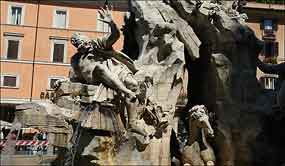

Sant'Agnese is built on the legendary location where St. Agnes was reputed to have performed her miracle: her hair instantly grew long enough to cover her naked body after being attacked by Roman soldiers. The church, dedicated in mid-17th century, was a private chapel for Pope Innocent X, head of the wealthy Pamphili family whose palace is next door, currently housing the Brazilian Embassy.
Along with a brilliant Fountain of the Four Rivers by Bernini in the center of the Piazza, there are two major fountain clusters at opposing ends: the Fountain of the Moors at the south end of the Piazza, designed in part by Bernini, and at the north end, Neptune astride sea creatures while being heralded by horn-blowing figures.
Exit the Piazza by taking the lane across from Sant'Agnese, but stop at the corner to turn around and look back at one of the most beautiful vistas in all of Rome: the fountain and obelisk, with Sant'Agnese forming the perfect backdrop. Snap your photo, even though the lighting is better first thing in the morning.

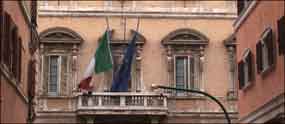
Upon leaving the Piazza Navona at Corso del Rinascimento, you will come upon the Roman Senate housed in the noble Palazzo Madama, which the Medicis built during the 16th century. Not open to the public, it is guarded by several police standing out front – they always seem to always select the tallest and most handsome officers for this job, coutured in beautiful uniforms designed by Giorgio Armani.
Palazzo Madama was the home of Pope Leo X, who was quite a character, reigning 1513-1521. Leo, successor to Julius II, reigned during the time that St. Peter's was being constructed and played a major role in raising money for that work, primarily by selling indulgences which supposedly forgave all sins and guaranteed the donor entrance to heaven. This scheme was seen as financial corruption and enraged many, like Martin Luther who responded by breaking away from the Catholic Church and starting the Protestant revolution.
Leo X was one of the popes in the Medici dynasty which ruled Florence for several centuries. The Medicis were among the most powerful families in the world with banking interests extending throughout Europe. Leo, the son of Lorenzo the Magnificent who was perhaps the greatest of all Medicis, came to office with an inflated sense of himself. He is famous for declaring "I've inherited the papacy so I'm going to enjoy it," which he did with an extravagant lifestyle that included mistresses and wild soirées in this palace. Perhaps that is why he was the last pope who was not a priest. Another famous Medici, Catherine, lived here until she moved to Paris in 1547 and became the Queen of France. The façade of the palace was built later, in the Baroque style. Today, the Italian Senate meets in here, but the main legislative branch, the Chamber of Deputies or lower house of the Parliament, is housed five blocks over toward Spagna.
.jpg)
.jpg)
SAN LUIGI
From Palazzo Madama, walk two short blocks towards the best-preserved ancient building in Rome, the Pantheon. But along the way there is a major artistic bonus hidden inside a church, San Luigi dei Francesi (unless you are here between noon and 4pm when it is closed for siesta). San Luigi was built in the 16th century as a church for the French community and many people pass right on by without realizing there are three artistic treasures inside.
The main attractions are three paintings by Caravaggio depicting the life of Saint Matthew found in the small Contarelli Chapel on the left front side of San Luigi and put a coin in the light box to bring out Caravaggio's brilliant colors.
Focus especially on the left painting, one of Caravaggio's greatest masterpieces, the Calling of St. Matthew. It dramatically depicts Christ pointing his finger at Matthew whose startled response seems to be "You want me?" To get the best angle you need to stand to the right, near the wall, perhaps dodging the frequent crowds who also want to get a look at this stunning painting practically hidden away in this remote corner.
Christ is on the far right side of the painting and has entered the room with Peter, dressed in the golden and blue robe, his traditional colors. Christ's hand is visually separated from his body by Peter, yet we know that it is Christ pointing. Matthew is the tax collector sitting at the table and counting money along with these ordinary working folks, the kinds of people Caravaggio specialized in painting to show the true grit of real life. Each figure is realistically illuminated with highlights and shadows that give real substance.
.jpg)
Two other paintings in this chapel depict scenes of Matthew: on the right side, he is dying a martyr, and in the middle, he is being dictated to by an angel who seems to be counting the blessed ideas with his fingers – divine inspiration coming to Matthew while he is writing the Gospel. All three canvases were painted for this Chapel, Caravaggio's earliest religious work, and they've been here ever since.
Caravaggio is noted for the bright highlights and shadows you see here, the chiaroscuro effects of the light and shadows creating three-dimensionality with motion. This lighting effect was invented by Caravaggio and had enormous influence on most artists who followed him, yet he never had a "school" of apprentices. In his personal life, the artist was a loner, a tragic figure who did not get along well with others and was forced to permanently flee from Rome after killing someone in a fight several blocks from this church.
When finished admiring these Caravaggios, continue one block on a pedestrian alley, Via Giustiniani, to the Pantheon and take a break for lunch at one of the many restaurants in this neighborhood.
